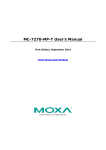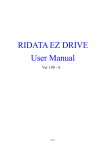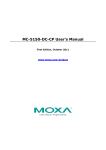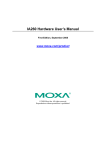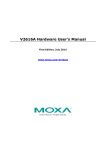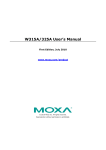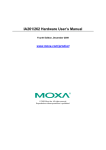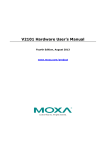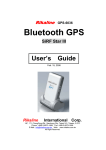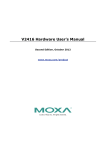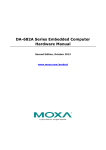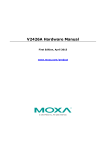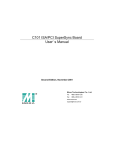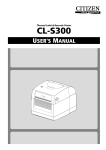Download MC-7130-MP Hardware Manual
Transcript
MC-7130-MP Hardware Manual Third Edition, March 2014 www.moxa.com/product © 2014 Moxa Inc. All rights reserved. MC-7130-MP Hardware Manual The software described in this manual is furnished under a license agreement and may be used only in accordance with the terms of that agreement. Copyright Notice © 2014 Moxa Inc., All rights reserved. Trademarks The MOXA logo is a registered trademark of Moxa Inc. All other trademarks or registered marks in this manual belong to their respective manufacturers. Disclaimer Information in this document is subject to change without notice and does not represent a commitment on the part of Moxa. Moxa provides this document as is, without warranty of any kind, either expressed or implied, including, but not limited to, its particular purpose. Moxa reserves the right to make improvements and/or changes to this manual, or to the products and/or the programs described in this manual, at any time. Information provided in this manual is intended to be accurate and reliable. However, Moxa assumes no responsibility for its use, or for any infringements on the rights of third parties that may result from its use. This product might include unintentional technical or typographical errors. Changes are periodically made to the information herein to correct such errors, and these changes are incorporated into new editions of the publication. Technical Support Contact Information www.moxa.com/support Moxa Americas Moxa China (Shanghai office) Toll-free: 1-888-669-2872 Toll-free: 800-820-5036 Tel: +1-714-528-6777 Tel: +86-21-5258-9955 Fax: +1-714-528-6778 Fax: +86-21-5258-5505 Moxa Europe Moxa Asia-Pacific Tel: +49-89-3 70 03 99-0 Tel: +886-2-8919-1230 Fax: +49-89-3 70 03 99-99 Fax: +886-2-8919-1231 Table of Contents 1. Introduction ...................................................................................................................................... 1-1 Overview ........................................................................................................................................... 1-2 Package Checklist ............................................................................................................................... 1-2 Product Features ................................................................................................................................ 1-2 Hardware Specifications ...................................................................................................................... 1-3 Hardware Block Diagram .............................................................................................................. 1-5 2. Hardware Introduction...................................................................................................................... 2-1 Appearance........................................................................................................................................ 2-2 Front View .................................................................................................................................. 2-2 Rear View ................................................................................................................................... 2-2 Dimensions ........................................................................................................................................ 2-3 LED Indicators .................................................................................................................................... 2-4 Real Time Clock .................................................................................................................................. 2-4 3. Hardware Connection Description ..................................................................................................... 3-1 Installing the MC-7130-MP ................................................................................................................... 3-2 Wiring Requirements ........................................................................................................................... 3-2 Connecting the Power ......................................................................................................................... 3-3 Grounding the MC-7130-MP ................................................................................................................. 3-3 Connecting Data Transmission Cables ................................................................................................... 3-3 Connecting to the Network ........................................................................................................... 3-3 Connecting to a Serial Device ....................................................................................................... 3-4 Connecting a PS/2 Keyboard and Mouse ................................................................................................ 3-5 Connecting to the USB Device .............................................................................................................. 3-5 Connecting to Digital Input and Output Channels .................................................................................... 3-5 Connecting to a VGA Monitor................................................................................................................ 3-6 Connecting to a DVI-D Monitor ............................................................................................................. 3-6 Connecting to a Speaker/Headphone/Microphone ................................................................................... 3-7 Installing the Removable SATA Storage Drive......................................................................................... 3-7 Installing the Internal SATA Storage Drive ............................................................................................. 3-8 Installing PCI and PCIe Cards ............................................................................................................. 3-10 Upgrading the Memory Module ........................................................................................................... 3-11 4. BIOS Setup........................................................................................................................................ 4-1 Entering the BIOS Setup Utility ............................................................................................................ 4-2 Main Information ................................................................................................................................ 4-3 Advanced Settings .............................................................................................................................. 4-3 Boot Configuration....................................................................................................................... 4-3 Peripheral Configuration ............................................................................................................... 4-4 HDC Configuration ....................................................................................................................... 4-5 Video Configuration ..................................................................................................................... 4-6 Chipset Configuration................................................................................................................... 4-8 Hardware Monitor ........................................................................................................................ 4-9 Security Settings ................................................................................................................................ 4-9 TPM Status ................................................................................................................................. 4-9 TPM Operation ............................................................................................................................ 4-9 Set Supervisor Password ............................................................................................................ 4-10 Power Settings ................................................................................................................................. 4-10 Advanced CPU Control ............................................................................................................... 4-10 Boot Settings ................................................................................................................................... 4-12 Boot Type................................................................................................................................. 4-12 Quick Boot ............................................................................................................................... 4-12 PXE Boot to LAN ........................................................................................................................ 4-12 Add Boot Options ...................................................................................................................... 4-12 USB Boot ................................................................................................................................. 4-12 EFI Device First ......................................................................................................................... 4-13 Boot Delay Time........................................................................................................................ 4-13 Legacy ..................................................................................................................................... 4-13 Exit Settings .................................................................................................................................... 4-14 Exit Saving Changes .................................................................................................................. 4-14 Save Change Without Exit .......................................................................................................... 4-14 Exit Discarding Changes ............................................................................................................. 4-14 Load Optimal Defaults ................................................................................................................ 4-14 Load Custom Defaults ................................................................................................................ 4-14 Save Custom Defaults ................................................................................................................ 4-15 Discard Changes ....................................................................................................................... 4-15 Upgrading the BIOS .......................................................................................................................... 4-16 A. Regulatory Approval Statement ........................................................................................................ A-1 B. Adjusting the Audio Mixer Function................................................................................................... B-1 1 1. Introduction The MOXA MC-7130-MP marine computer is powered by the third generation Intel® Core™ i3 3120ME processor and offers a wide range of I/O connectivity that includes eight NMEA 0183 ports, four serial ports, four Gigabit Ethernet ports, six USB 2.0 and two SuperSpeed USB 3.0 ports. In addition, it also provides a third generation PCIe x16 slot alongside two standard PCI slots, allowing versatile peripheral expansion for industrial applications. The MC-7130-MP’s rugged and fanless design and 1G anti-vibration make it particularly well-suited for bridge systems in marine applications. In addition, the compact size and low power consumption ensure an easy installation and dependable service, while its modular design allows easy integration with existing displays. Users can easily install Windows 7, Windows XP SP3, or Windows XP Embedded to provide a flexible and friendly environment for system development and application implementation. The following topics are covered in this chapter: Overview Package Checklist Product Features Hardware Specifications Hardware Block Diagram MC-7130-MP Series Introduction Overview The MOXA MC-7130-MP marine computer is powered by the third generation Intel® Core™ i3 3120ME processor and offers a wide range of I/O connectivity including eight NMEA 0183 ports, four serial ports, four Gigabit Ethernet ports, six USB 2.0 and two SuperSpeed USB 3.0 ports. In addition, it also provides a third generation PCIe x16 slot alongside two standard PCI slots, allowing versatile peripheral expansion for industrial applications. Users can also choose to install Windows 7, Windows XP SP3, or Windows XP Embedded operating systems to provide a flexible and friendly environment for system development and application implementation. Package Checklist One MC-7130-MP: A ready-to-run x86 computing platform with Intel Core™ i3 3120E, 4 serial ports, 4 Gigabit Ethernet ports, 6 USB hosts, 8 NMEA ports, storage drives, and VGA/DVI-D video outputs. Each model ships with the following items: NOTE • 1 MC-7130-MP marine computer • 2 storage protection locks (with keys) • 8 screws for drive mounts • Wall mounting kit, with 6 screws • 1 terminal block for DC power input • 2 6-pin digital input terminal blocks • 2 8-pin digital output terminal blocks • 8 NMEA 0183 ports • Documentation and driver CD • Quick Installation Guide (printed) • Warranty card Please notify your sales representative if any of the above items are missing or damaged. Product Features The MC-7130-MP embedded computer has the following features: • High-performance 3rd generation Intel Core i3 3120ME processor • Built-in 4 GB DDR3 memory, with additional capacity up to 16 GB • Supports three independent displays (2 DVI-D + 1 VGA) • 4 Gigabit Ethernet ports for network redundancy • 1 PCIe (x16) slot, 2 universal PCI slots • 2 software-selectable RS-232/422/485 serial ports • 2 RS-232 ports • 8 NMEA 0183 ports • 6 USB 2.0 hosts, 2 USB 3.0 ports • 2 integrated SATA 6 Gbps and 2 SATA 3 Gbps interfaces for high speed storage expansion • Trusted Platform Module: integrated hardware-level security for maximum data protection • 1G anti-vibration design for system reliability • 24 VDC and 100 to 240 VAC power input • Supports Windows XP Embedded, Windows XP SP3, or Windows 7 1-2 MC-7130-MP Series Introduction Hardware Specifications Computer CPU: Intel® Core™ i3-3120ME (BGA CPU package), dual core threaded 64 bit 2.4 GHz processor OS: Windows 7, Windows XP SP3, Windows XP Embedded (must be installed by the user) System Chipset: Intel® QM77 Express Chipset System Memory: 16 GB capacity, 4 GB pre-installed: 2 slots of 8 GB DDR3-1066 204 pin SO-DIMM SDRAM USB: USB 2.0 host x 6, USB 3.0 host x 2, Type A connectors Storage Storage Support: • 2 SATA 6 Gb/s ports for SSD/HDD • 2 SATA 3 Gb/s ports for SSD/HDD Other Peripherals KB/MS: 2 PS/2 interfaces supporting standard PS/2 keyboard and mouse Audio: Line in x 1, Line out x 1, Mic in x 1 LPT Port: 1 PCIe x16 Slots: 1 PCI Slots: 2 Display Graphics Controller: Onboard Intel® HD 4000 graphics Display Interface: • VGA Interface x 1: 15-pin D-Sub connector (female), with resolution up to 1920 x 1080 • DVI-D Interface x 2: 29-pin DVI-D connectors (female), with resolution up to 1920 x 1080, 60Hz (with reduced blanking) Ethernet Interface LAN: 4 auto-sensing 10/100/1000 Mbps ports (RJ45) Magnetic Isolation Protection: 1.5 KV built in Serial Interface Serial Standards: • 2 RS-232/422/485 ports, software-selectable (DB9 male) • 2 RS-232 ports (DB9) • 8 NMEA 0183 terminals (NMEA 2000 available on request) Serial Communication Parameters Data Bits: 5, 6, 7, 8 Stop Bits: 1, 1.5, 2 Parity: None, Even, Odd, Space, Mark Flow Control: RTS/CTS, XON/XOFF, ADDC® (automatic data direction control) for RS-485 Baudrate: 50 bps to 230.4 Kbps Serial Signals RS-232: TxD, RxD, DTR, DSR, RTS, CTS, DCD, GND RS-422: TxD+, TxD-, RxD+, RxD-, GND RS-485-4w: TxD+, TxD-, RxD+, RxD-, GND RS-485-2w: Data+, Data-, GND NMEA Interface Serial Standards: NMEA 0183v2 (NMEA 2000 available on request) Base Serial Standard: • NMEA 0183: RS-422 • NMEA 2000: CAN bus (Available on request) Optical Isolation Protection: 3 KV Voltage Differential: -15 V to +15 V Baudrate: 4800 bps Data Bits: 8 1-3 MC-7130-MP Series Introduction Stop Bits: 1, 1.5, 2 Parity: None Handshake: None Digital Input Input Channels: 8 dry channels, with 4 grounds Digital Input Levels for Dry Contacts: • Logic level 0: Close to GND • Logic level 1: Open Connector Type: 6-pin Phoenix-compatible 3.81 mm screw terminal block, x 2 Isolation: ESD protection to DNV specifications Relay Output Type: Form A (N.O.) power relay Output Channels: 8 output channels Contact Rating: 2A, 30Vdc /0.5A, 125Vac under resistor load Initial Insulation Resistance: 1000M ohm (min.) @500VDC Mechanical Endurance: 100,000 operations @2A, 30VDC resistive load Electrical Endurance: 100,000,000 operations Contact Resistance: Max. 50m ohm @6V, 0.1A Connector Type: 8-pin Phoenix-compatible 3.81 mm screw terminal block, x 2 Isolation: Relay isolation; ESD protection to DNV specifications LEDs System: Storage, Power LAN: 100M/Link x 4, 1000M/Link x 4 (on connector) Physical Characteristics Housing: Aluminum, sheet metal Weight: 8 kg Dimensions: 322 x 300 x 150 mm (12.68 x 11.81 x 5.91 in) System Cooling: Moxa AI-Fan Mounting: Wall Environmental Limits Operating Temperature: -15 to 55°C (5 to 131°F) Storage Temperature: -20 to 60°C (-4 to 131°F) Ambient Relative Humidity: 5 to 95% (non-condensing) Anti-Vibration: • 0.7 g @ DNV 2.4 (Class A), sine wave, 2-100 Hz, 1 Oct./min., 1.5 hr per axis • 1 grms @ DNV 2.4, random wave, 3-100 Hz, 2.5 hr per axis • 2.1 g @ DNV 2.4 (Class C), sine wave, 2-50 Hz, 1 Oct./min., 1.5 hr per axis Power Requirements Input Voltage: • DC: 24 VDC (with tolerance from 18 to 30 VDC, 2-pin terminal block) • AC: 100 to 240 VAC Power Consumption: Less than 100 W, 2.5 A @ 24 VDC Standards and Certifications Safety: UL 60950-1, DNV 2.4 (Pending), IEC 60945 (4th) (Pending), IACS-E10 (Pending), CCC (GB4943, GB9254, GB17625.1) (Pending) EMC: EN 55022 Class B, EN 55024-4-2, EN 55024-4-3, EN 55024-4-4, FCC Part 15 Subpart B Class B Marine: IEC 60945 4th. (Pending), IACS-E10 (Pending) Green Product: RoHS, cRoHS, WEEE Reliability MTBF (mean time between failures): • Telcordia (Bellcore) Standard TR/SR: 269,934 hrs • MIL-HDBK-217 FN2: 114,305 hrs 1-4 MC-7130-MP Series Introduction Warranty Warranty Period: 3 years Details: See www.moxa.com/warranty Hardware Block Diagram 1-5 2 2. Hardware Introduction The MC-7130-MP computer is compact, well-designed, and built rugged enough for industrial applications. LED indicators help you monitor performance and identify trouble spots, multiple serial ports allow you to connect different devices, and the reliable and stable hardware platform lets you devote your attention to developing your applications. The following topics are covered in this chapter: Appearance Front View Rear View Dimensions LED Indicators Real Time Clock MC-7130-MP Series Hardware Introduction Appearance Front View Rear View 2-2 MC-7130-MP Series Hardware Introduction Dimensions 2-3 MC-7130-MP Series Hardware Introduction LED Indicators LED Name LED Color LED Function Power Green Power is on and functioning normally (on front panel) Off Power is off or power error exists Storage Storage disk is functioning properly Red (on) (on front panel) Red (blinking) Off LAN (1 to 4) Green (on connectors) Yellow Off Storage disk is accessing data No activity 100 Mbps Ethernet mode 1000 Mbps (Gigabit) Ethernet mode No activity or 10 Mbps Ethernet mode Real Time Clock The embedded computer’s real-time clock is powered by a lithium battery. We strongly recommend that you NOT replace the lithium battery on your own. If the battery needs to be changed, contact the Moxa RMA service team at http://www.moxa.com/rma/about_rma.aspx. ATTENTION Used batteries are environmentally hazardous materials. Dispose of them in the proper manner. WARNING There is a risk of explosion if the wrong type of battery is used. To avoid this potential danger, always be sure to use the correct type of battery. Contact the Moxa RMA service team if you have any questions about replacing your battery. 2-4 3 3. Hardware Connection Description In this chapter, we show how to connect the embedded computers to the network and to various devices. The following topics are covered in this chapter: Installing the MC-7130-MP Wiring Requirements Connecting the Power Grounding the MC-7130-MP Connecting Data Transmission Cables Connecting to the Network Connecting to a Serial Device Connecting a PS/2 Keyboard and Mouse Connecting to the USB Device Connecting to Digital Input and Output Channels Connecting to a VGA Monitor Connecting to a DVI-D Monitor Connecting to a Speaker/Headphone/Microphone Installing the Removable SATA Storage Drive Installing the Internal SATA Storage Drive Installing PCI and PCIe Cards Upgrading the Memory Module MC-7130-MP Series Hardware Connection Description Installing the MC-7130-MP Wall or Cabinet Mounting The MC-7130-MP provides two brackets for mounting, either onto walls or into cabinets. Attach the brackets with the screws included on both sides of the chassis. Wiring Requirements You should read and follow these common safety precautions before proceeding with the installation of any electronic device: • Use separate paths to route wiring for power and devices. If power wiring and device wiring paths must cross, make sure the wires are perpendicular at the intersection point. NOTE Do not run signal or communication wiring together with power wiring in the same wire conduit. To avoid interference, wires with different signal characteristics should be routed separately. • Use the type of signal transmitted through a wire to determine which wires should be kept separate. The rule of thumb is that wiring that shares similar electrical characteristics can be bundled together. • Keep input wiring and output wiring separate. • It is advisable to label the wiring on all devices in the system. ATTENTION Safety First! Be sure to disconnect the power cord before installing and/or wiring your MC-7130-MP. Wiring Caution! Calculate the maximum possible current in each power wire and common wire. Observe all electrical codes dictating the maximum current allowable for each wire size. If the current goes above the maximum ratings, the wiring could overheat, causing serious damage to your equipment. Temperature Caution! Be careful when handling the unit. When the unit is plugged in, the internal components generate heat, and consequently the outer casing may feel hot to the touch. 3-2 MC-7130-MP Series Hardware Connection Description Connecting the Power The MC-7130-MP comes with a 100 to 240 VAC power input, and also has a 24 VDC power input (via the terminal block). If power is supplied properly, the Power LED will light up. For safety reasons, please use cables with the following specifications: Wire range: 14-22 AWG Torque: 7 lb Grounding the MC-7130-MP Grounding and careful wire routing help limit the effects of noise due to electromagnetic interference (EMI). Run the ground connection from the ground screw to the grounding surface prior to connecting the power. ATTENTION This product is intended to be mounted on a well-grounded surface, such as a metal panel. Earthing/Grounding Wire: See the figure shown below for the location of the earth ground on the terminal block power connector. Connect the EG wire to an appropriately grounded metal surface. Connecting Data Transmission Cables This section describes how to connect the MC-7130-MP computer to the network and/or serial devices. Connecting to the Network Plug your network cable into the computer’s Ethernet port. The other end of the cable should be plugged into your Ethernet networking device. When the cable is properly connected, the LEDs on the embedded computer’s Ethernet port will glow to indicate a valid connection. The 10/100/1000 Mbps Ethernet LAN ports use 8-pin RJ45 connectors. The following diagram shows the pinouts for these ports. 3-3 MC-7130-MP Series Hardware Connection Description The LED indicators on the right-top (for the upper LAN connector) and right-bottom (for the lower LAN connector) corners glow a solid green color when the cable is properly connected to a 100 Mbps Ethernet network. The LED will flash on and off when Ethernet packets are being transmitted or received. The LED indicators on the left-top and left-bottom corners glow a solid yellow color when the cable is properly connected to a 1000 Mbps Ethernet network. The LED will flash on and off when Ethernet packets are being transmitted or received. Pin 10/100 Mbps 1000 Mbps 1 ETx+ TRD(0)+ 2 ETx- TRD(0)- 3 ERx+ TRD(1)+ 4 --- TRD(2)+ 5 --- TRD(2)- 6 ERx- TRD(1)- 7 --- TRD(3)+ 8 --- TRD(3)- Connecting to a Serial Device The serial ports use DB9 connectors. COM1 and COM2 can run with RS-232, and COM3 and COM4 run with RS-232, RS-422, or RS-485. The pin assignments are shown in the following table: DB9 Male Port RS-232/422/485 Pinouts Pin RS-232 RS-422 RS-485 RS-485 (4-wire) (2-wire) 1 DCD TxDA(-) TxDA(-) – 2 RxD TxDB(+) TxDB(+) – 3 TxD RxDB(+) RxDB(+) DataB(+) 4 DTR RxDA(-) RxDA(-) DataA(-) 5 GND GND GND GND 6 DSR – – – 7 RTS – – – 8 CTS – – – Additionally, eight NMEA serial ports with terminal blocks are also available on the rear panel of the computer. Refer to the following figures for the location of the NMEA ports and the pin assignments. 3-4 MC-7130-MP Series Hardware Connection Description Connecting a PS/2 Keyboard and Mouse Your MC-7130-MP computer comes with 2 PS/2 mini-DIN connectors on the rear panel to connect to a PS/2 keyboard and PS/2 mouse. This 6-pin mini-DIN connector has the pin assignments shown below. PS/2 Connector Pin No. Signal Definition 1 PS/2 Keyboard Data 2 PS/2 Mouse Data 3 GND 4 VCC 5 PS/2 Keyboard Clock 6 PS/2 Mouse Clock Connecting to the USB Device The MC-7130-MP comes with two USB 2.0 hosts on the front panel, four USB 2.0 hosts, and two SuperSpeed USB 3.0 hosts on the rear panel. The USB ports support peripherals such as a keyboard or mouse, or storage devices such as a portable HDD or DVD-ROM. Please note that USB 3.0 interfaces are not supported by the Windows XP platform. Connecting to Digital Input and Output Channels The MC-7130-MP comes with eight digital input and eight digital output channels on the rear panel. These input/output channels can be connected with the terminal blocks which have been included in the package. See the following figure for the pin assignments. 3-5 MC-7130-MP Series Hardware Connection Description Connecting to a VGA Monitor The MC-7130-MP comes with a D-Sub 15-pin female connector on the rear panel to connect a VGA CRT monitor. To ensure that the monitor image remains clear, be sure to fasten the monitor cable using the cable’s thumbscrews after connecting it to the MC-7130-MP. The pin assignments of the VGA connector are shown below. DB15 Female Connector Pin No. Signal Definition 1 Red 2 Green 3 Blue 4 NC 5 GND 6 GND 7 GND 8 GND 9 VCC 10 GND 11 NC 12 DDC Data 13 HSYNC 14 VSYNC 15 DDC Clock Connecting to a DVI-D Monitor The MC-7130-MP computers come with two DVI-D connectors that can connect to DVI monitors. Use the cable to connect one end to the DVI-I connector and the other end to the monitor. See the following table for DVI-D connector pin assignments. Please note that three independent displays are not supported under the Windows XP operating system. DVI-D Connector Pin No. Signal Definition Pin No. Signal Definition 1 T.M.D.S. Data2- 13 N/C 2 T.M.D.S. Data2+ 14 +5V Power 3 T.M.D.S. Data2/4 Shield 15 Ground 4 N/C 5 N/C 16 Hot Plug Detect 6 DDC Clock 17 T.M.D.S. Data0- 7 DDC Data 18 T.M.D.S. Data0+ 8 Analog Vertical Sync 19 T.M.D.S. Data0/5 Shield 9 T.M.D.S. Data1- 20 N/C 10 T.M.D.S. Data1+ 21 N/C 11 T.M.D.S. Data1/3 Shield 22 T.M.D.S. Clock Shield 12 N/C 23 T.M.D.S. Clock+ 24 T.M.D.S. Clock- (return for +5V, HSync, and VSync) 3-6 MC-7130-MP Series Hardware Connection Description Connecting to a Speaker/Headphone/Microphone The MC-7130-MP comes with audio input, output, and microphone interfaces on the rear panel for connecting a microphone, speaker, or headphones. Installing the Removable SATA Storage Drive The MC-7130-MP computer comes with a removable SATA storage device tray that is accessible through the front panel. Either a SATA hard disk or solid state drive may be installed, but only use of an SSD will ensure full anti-vibration compliance. To install a SATA storage device, please follow these instructions: 1. Disconnect the MC-7130-MP from the power source. 2. To remove the storage device tray, insert the protection key and turn it to the right, then unfasten the two thumbscrews that secure the removable tray. The storage tray’s location may be seen in the following figure: 3. Take off the storage bracket from the slot and turn it over to get access to the four screws which will secure the drive to the tray. 4. Place the drive into the tray and secure it using the four screws. When finished, insert the tray into the computer and fasten the tray in place using the two thumbscrews on the front panel. Finally, complete the installation by turning the key leftwards to lock the tray into place. 3-7 MC-7130-MP Series Hardware Connection Description Installing the Internal SATA Storage Drive The MC-7130-MP has a SATA connector within the main chassis where a SATA storage drive may be permanently installed. To install a 2.5-inch SATA storage drive, follow these instructions. Turn over the MC-7130-MP to get access to its bottom panel; remove the four screws on the drive bay cover plate. The following figure shows what the location of the screws: After removing the cover plate, you will need to install the storage drive. Removing the Computer Chassis 1. Remove the five screws on the top cover of the computer. 2. Remove the eight screws fastening each side of the computer (16, total). 3-8 MC-7130-MP Series Hardware Connection Description 3. The internal drive slot is located below the removable drive slot. Turn the drive so that its connectors are facing towards you and insert it into the slot. Connect the SATA connector and SATA power cable. When finished, push the drive inward. 4. Fasten the two screws on either side of the HDD slot. 5. Remember to replace the top cover on the computer to complete the installation. 3-9 MC-7130-MP Series Hardware Connection Description Installing PCI and PCIe Cards The MC-7130-MP has two universal PCI slots for installing various peripheral cards, such as a RADAR card or PROFIBUS card. Also, a PCIe (x16) card is available for connecting an additional VGA graphic card. To install: 1. Unfasten the computer chassis (see the above section, Removing the Computer Chassis). 2. Remove the chassis to expose the PCI slots located in the corner of the computer’s motherboard. 3. Remove the screws on the slot protection covers. 4. Insert the PCI card or PCI-e card into the slot, and secure the card to the mounting frame. 6. When finished, replace the top cover of the computer and complete the installation. NOTE Due to the limitations of Intel architecture, native PCI bus is not available; a PCIe-to-PCI bridge design is required. For some PCI cards this may reduce performance during I/O space access data transfers. 3-10 MC-7130-MP Series Hardware Connection Description Upgrading the Memory Module The MC-7130-MP comes with four gigabytes of pre-installed DDR3 SDRAM, and can support another 12 gigabytes (up to a total of sixteen). If you would like to install more memory modules, please follow the steps below. 1. Remove the cover (see the above section, Removing the Computer Chassis). 2. The memory module is located below the internal HDD socket. 3. Simply push the two clutches on both sides of the memory module, and then remove the memory. 4. Carefully slide the module into the clutch at an angle, and then push downward. Make sure the module has been firmly inserted and is oriented correctly. 3-11 4 4. BIOS Setup This chapter describes the BIOS settings of the MC-7130-MP computer. The BIOS is a set of input/output control routines for peripherals. The BIOS is used to initialize basic peripherals and helps boot the operating system before the operating system is loaded. The BIOS setup allows the user to modify the system configurations of these basic input/output peripherals. The following topics are covered in this chapter: Entering the BIOS Setup Utility Main Information Advanced Settings Boot Configuration Peripheral Configuration HDC Configuration Video Configuration Chipset Configuration Hardware Monitor Security Settings TPM Status TPM Operation Set Supervisor Password Power Settings Advanced CPU Control Boot Settings Boot Type Quick Boot PXE Boot to LAN Add Boot Options USB Boot EFI Device First Boot Delay Time Legacy Exit Settings Exit Saving Changes Save Change Without Exit Exit Discarding Changes Load Optimal Defaults Load Custom Defaults Save Custom Defaults Discard Changes Upgrading the BIOS MC-7130-MP Series BIOS Setup Entering the BIOS Setup Utility To enter the BIOS setup utility, press the “F2” key while the system is booting up. The main BIOS Setup screen will appear. Select SCU to enter the BIOS configuration. A basic description of each function key is listed at the bottom of the screen. Refer to these descriptions to learn how to use them. F1: General Help F5/F6: Change Values F9: Setup Defaults F10: Save and Exi ↑↓: Select Item ← →: Select Menu ESC: Exit ENTER: Select or go to Submenu. 4-2 MC-7130-MP Series BIOS Setup Main Information The main page indicates the system information, such as model name, BIOS version, and CPU type. User may view the basic system hardware information in the page. Advanced Settings The “Advanced Features” screen will appear when choosing the “Advanced” item from the main menu. Boot Configuration This item allows users to configure the default value of Numlock. 4-3 MC-7130-MP Series BIOS Setup Option: On (default), Off. Peripheral Configuration This item allows you to configure the parallel port and audio device. Parallel Port This item allows you to configure the parallel port. Options: 378/IRQ7 (default), Disabled Mode This setting allows you to configure the mode for the parallel port. Options: SPP (default), EPP, ECP, EPP+ECP Audio The item allows you to configure if the system will automatically detect the Audio codec. 4-4 MC-7130-MP Series BIOS Setup Options: Enabled (default), Disable. HDC Configuration The host drive controller may be configured for IDE (legacy default), AHCI, or RAID mode. When the legacy IDE mode is selected, the following screen will appear. When RAID mode is selected, the following screen will appear. Select Software Feature Mask Configuration to choose which RAID configuration you want to set up. . The Software Feature Mask Configuration will appear as below. 4-5 MC-7130-MP Series BIOS Setup RAID 0 is a simple striping of information across two drives. It offers marginal improvements in access times for substantial sacrifices in system reliability. RAID 1 offers full data redundancy across two drives, providing significant improvements in data security and system reliability. RAID 10 offers the best of both RAID 0 and RAID 1, using four drives to give moderate improvements in disk access times, but with full mirroring of each drives on two more backup drives to provide full data redundancy and backup. RAID 5 is a three-disk-or-more array where data is striped and parity is distributed and reduplicated across all drives. This enables the array to sustain the failure of one of the drives without the loss of any data, and without the array going down. However, with the loss of any single drive the array performance will decrease. Also, when configuring a RAID 5 architecture, remain aware of the potential for encountering the RAID 5 write hole problem, and take precautions against it. Serial ATA Port 0 to 3 This setting allows the user to display information about the installed drives. AHCI SALP Please note that AHCI SALP will only appear when AHCI mode is selected. This item allows you to enable aggressive link power management (SALP) in AHCI. SALP enables the host bus adapter to conserve power by directly detecting when a SATA drive is no longer processing information and then immediately shifting it into suspended or sleep modes without waiting for software processes to initiate power-down processes. Host Capability Register bit 26. Options: Enabled (default), Disabled SATA Port 0 to 3 - HotPlug This item allows you to enable/disable hotplug capabilities (the ability to remove the drive while the computer is running) for installed storage drives. Options: Disable (default), Enabled Video Configuration This item allows you to configure the integrated graphics device (IGD) for things like memory allocation (DVMT) and monitor types (Boot Type). Primary Display This item allows you to select the primary display source. Options: IGFX (default), PEG 4-6 MC-7130-MP Series BIOS Setup Internal Graphics Device This option allows you to enable/disable the internal graphics device. Options: Enable (default), Disable IGD—DVMT Pre-Allocated This item allows you to configure pre-allocated memory capacity for the IGD. Pre-allocated graphics memory is invisible to the operating system. Options: 64 MB (default), 32 MB, 96 MB, 128 MB, 256 MB, 512 MB DVMT is a BIOS solution where “the optimum amount of memory is dynamically allocated and de-allocated as needed for balanced graphics and system performance, through Intel® Direct AGP and a highly efficient memory utilization scheme. DVMT ensures the most efficient use of available system memory resources for maximum 2D/3D graphics performance. IGD—DVMT Size This item allows you to configure the maximum amount of memory DVMT will use when allocating additional memory for the internal graphics device. Options: 256 MB (default), 128 MB, Max IGD – Boot Type This item allows you to select the video device which will be activated during POST. Options: VBIOS Default (default), VGA, DVI-D2, DVI-D1 4-7 MC-7130-MP Series BIOS Setup Chipset Configuration This item allows you to configure the chipset settings. VT-d This item allows you to enable/disable the VT-d function. Options: Enable (default), Disable Interrupt Remapping This item allows you to remap interrupts to different address to resolve interrupt conflicts. Options: Disable (default), Enable Pass-Through DMA This item allows you to enable/disable Pass-Through DMA function. Options: Disable (default), Enable Power ON after Power Fail This item allows you to enable/disable the computer form automatically powering up after a system crash. Options: ON (default), OFF, Last State 4-8 MC-7130-MP Series BIOS Setup Hardware Monitor This item allows you to view stats like CPU and system temperature, voltage levels, and other chipset information. Please note that the CPU fan will not start until the temperature is above 80 degrees Celsius. Security Settings This section allows users to configure security settings with a supervisor password and user password. TPM Status This item allows you to view the TPM status.. TPM Operation This item allows you to enable/disable the TPM Operation function. Options: No Operation (default), Enable and Active, Disable and Deactivate 4-9 MC-7130-MP Series BIOS Setup Set Supervisor Password This item allows you set the supervisor password. Select and then enter the password, and then confirm the password again. To delete the password, enter Set Supervisor Password and then enter the old password; then, leave the new password fields blank, and press enter. Power Settings The section allows users to configure power settings. Advanced CPU Control 4-10 MC-7130-MP Series BIOS Setup P-States (IST) This item allows you to enable/disable Processor Performance States (P-States); these states allow you to choose the speed at which your processor will handle itself, thereby conserving energy during usage, or operating at the top speeds available (while consuming more energy). Options: Enabled (default), Disabled HT Support This item allows you to disable Hyper-Threading (HT). Options: Auto (default), Disabled Use XD Capability This item allows you to enable XD capability—the Execute Disable bit—in the processor. This will prevent the execution of code in data-only memory, giving some protection against buffer overflow attacks. It is recommended to enable this feature; however, some software applications (particularly device drivers) improve performance by executing some of their code from the kernel stack, and in these instances XD will cause page faults. In these cases, XD must be disabled. Options: Enabled (default), Disabled VT Support This item allows you to enable/disable Intel® Virtualization Technology, which gives additional hardware support when the system is running virtual operating systems. Options: Enabled (default), Disabled C-States This item allows you to enable/disable the processor idling states; these C-States conserve energy when the processor is not being used (or not being fully used). This saves considerable energy when the system is idling, but at the cost of a slow wakeup for the system when it has been idling for a long time. Options: Enabled (default), Disabled 4-11 MC-7130-MP Series BIOS Setup Boot Settings The section allows users to configure boot settings. Boot Type This item allows you to enable/disable quick boot function. Options: Dual Boot Type (default), Legacy Boot Type, UEFI Boot Type. Quick Boot This item allows you to enable/disable quick boot function. Options: Enabled (default), Disabled PXE Boot to LAN This item allows you to enable/disable PXE boot to LAN function. Options: Disabled (default), Enabled Add Boot Options This item allows you to add the boot order options for shell, network and Removables. Options: Last (default), First USB Boot This item allows you to enable/disable USB boot function.. Options: Enabled (default), Disabled 4-12 MC-7130-MP Series BIOS Setup EFI Device First This item allows you to determine EFI device first or legacy device first. If enabled, EFI device will be the first; if disabled, legacy device will be the first. Options: Disabled (default), Enabled Boot Delay Time This item allows you to configure the delay time value for users to input hot key during POST time. Options: 0 Second (default), 3 Seconds, 5 Seconds, 10 Seconds Legacy Normal Boot Menu This item allows you to configure the boot menu. Options: Normal (default), Advance Boot Type Order This item allows you to select the boot order. Use F5/F6 to change values. Options: Hard Disk Drive (default), CD/DVD-ROM Drive, USB, Others Hard Disk Drive/USB Drive This item allows you to view installed devices such as hard disk drives, USB drives, or CD-ROMs. For example, if you have inserted a USB drive into the computer, it will appear here. 4-13 MC-7130-MP Series BIOS Setup Exit Settings The section allows users to exit the BIOS environment. Exit Saving Changes This item allows you to exit the BIOS environment and save the values you have just configured. Options: Yes (default), No Save Change Without Exit This item allows you to save changes without exiting the BIOS environment. Options: Yes (default), No Exit Discarding Changes This item allows you to exit without saving any changes that might have been made to the BIOS. Options: Yes (default), No Load Optimal Defaults This item allows you to revert to the factory default BIOS values. Options: Yes (default), No Load Custom Defaults This item allows you to load custom default values for the BIOS settings. Options: Yes (default), No 4-14 MC-7130-MP Series BIOS Setup Save Custom Defaults This item allows you to save the current BIOS values as a “custom default” that may be reverted to at any time by the “load custom defaults” selection just above. Options: Yes (default), No Discard Changes This item allows you to discard all settings you have just configured. Options: Yes (default), No 4-15 MC-7130-MP Series BIOS Setup Upgrading the BIOS This section describes how to upgrade the BIOS. However, please note that upgrading the BIOS involves high risk of damage to your computer. We strongly recommend that you contact Moxa’s TS staff for assistance and obtain all necessary tools and files before attempting to upgrade. Step 1: Create a Bootable USB Disk We suggest you use the HP USB Disk Format Tool to create a bootable USB disk. You may download this tool from the Internet. Search the Internet using the phrase “HP USB Disk Storage Format Tool”, and then download the tool from one of the listed websites. You will also need to download the FreeDos system files kernel.sys and command.com from http://www.freedos.org/kernel/. 1.Copy DOS system files kernel.sys and command.com to a specified directory (C:\FreeDOS in this example). 2.Start the HP USB Disk Storage Format Tool and select the USB device that you want to use as a bootable disk in the Device drop down box. 3.Select FAT in the File system drop down box. 4.Type the disk name in the Volume label field. 5.Check the option Create a DOS startup disk under format options. 6.Specify the directory of the system files (for example, C:\FreeDOS). 7.Click Start to format and create the USB disk. ATTENTION We suggest you use a USB drive with under 2 GB in disk space, as larger USB drives may not support FAT file format and consequently fail to boot. Step 2: Prepare the Upgrade File You must use the BIOS upgrade installation file to upgrade the BIOS. Contact Moxa’s technical department for assistance. 1. Get the BIOS upgrade installation file. The file name should have following format: MC71xxSxx.exe (xx refers to version numbers). 2. Copy the file to the Bootable USB Disk. Step 3: Run the upgrade program on the MC-7130-MP Computer 1. Reboot the computer, press F12 while booting up to go to the Boot Manager 2. Select USB Disk as the first boot source. Press Enter to continue. 4-16 MC-7130-MP Series BIOS Setup 3. When boot up finishes, DOS screen will show up. Go to the directory where the upgrade file is located. For example, if the upgrade file is stored in the MC_7130 folder, type cd MC_7130 C:\cd MC_7130 4. Run the upgrade program by typing MC7130S03.exe. Please note that the upgrade filename may vary depending on the versions. C:\ MC_7130>MC7130S01.exe 5. The upgrade program will be automatically performed. Please wait until the procedure to be finished. 6. When the upgrade is finished, the computer will automatically reboot. You may check the BIOS version in Main page of the BIOS Setup 4-17 MC-7130-MP Series BIOS Setup ATTENTION Do NOT switch off the power supply during the BIOS upgrade, since doing so may cause the system to crash. 4-18 A A. Regulatory Approval Statement This device complies with part 15 of the FCC Rules. Operation is subject to the following two conditions: (1) This device may not cause harmful interference, and (2) this device must accept any interference received, including interference that may cause undesired operation. Class A: FCC Warning! This equipment has been tested and found to comply with the limits for a Class A digital device, pursuant to part 15 of the FCC Rules. These limits are designed to provide reasonable protection against harmful interference when the equipment is operated in a commercial environment. This equipment generates, uses, and can radiate radio frequency energy and, if not installed and used in accordance with the instruction manual, may cause harmful interference to radio communications. Operation of this equipment in a residential area is likely to cause harmful interference in which case the user will be required to correct the interference at his own expense. European Community Warning: This is a class A product. In a domestic environment this product may cause radio interference in which case the user may be required to take adequate measures. B B. Adjusting the Audio Mixer Function This chapter describes how to adjust the of the MC-7130-MP’s audio settings for the Mixer function in the Windows XP and Windows XP Embedded operating systems. Since the Mixer function is enabled by default, you need modify the default settings of the Realtek audio device so that sounds picked up from the microphone will not be recorded. Follow the steps below: 1. Right-click volume icon and select Open Volume Control. 2. Select Properties. 3. Select Realtek HD Audio Input from the Mixer device drop-down list, and check Stereo Mix. Click OK to continue. MC-7130-MP Series Adjusting the Audio Mixer Function 4. Uncheck Stereo Mix and choose Mix Volume to complete the configuration. B-2 MC-7130-MP Series Adjusting the Audio Mixer Function B-3















































